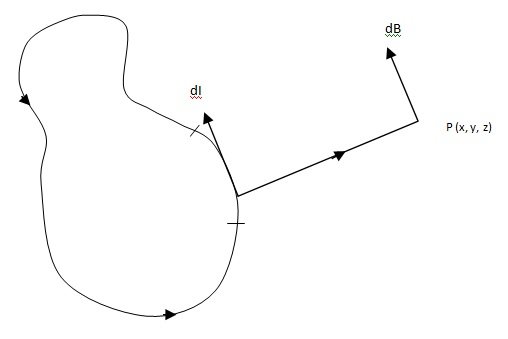Magnetic Vector Potential
Magnetic Vector Potential Assignment Help | Magnetic Vector Potential Homework Help
Magnetic Vector Potential
The calculation of electric fields was much simplified by the introduction of the electrostatic potential. For an electrostatic field, E and electrostatic potential V is given byE = - ∇ V
Here V is a scalar quantity.
In the case of a magnetic field,
div B = 0
Since the divergence of any curl is zero, it is reasonable to assume that the magnetic induction may be written
B = Curl A = ∇ x A
A refers to magnetic potential and is called the magnetic vector potential.
Therefore the magnetic vector potential A can be defined as the vector, whose curl at any point gives the value of the magnetic field B at that point.
The only other requirement placed on A is that
∇ x B = ∇ x [∇ x A] = μ0J
The units of A are WB/m or Tm
Let us derive an expression for the magnetic vector potential of a current loop.
According to the Biot-Savart law, the magnetic induction at a distance r from the element of length δI carrying a current I is given by
δB = μ0I/4π . δI x r/r3 … (1)
We have ∇ (1/r) = -r/r3 … (2)
δB = μ0I/4π δI x {- ∇(1/r)}
μ0I/4π {∇(1/r) x δI} … (3)
We have the vector identity
∇ x (ΦA) = (∇Φ) x A + Φ (∇xA)
Where Φ is a scalar and A is vector.
Or (∇Φ) x A = ∇ x (ΦA) – Φ (∇x A)
So ∇ (1/r) x δI = ∇x (δI/r) – 1/r (∇x δI) … (4)
Using Eq. (4) in Eq. (3), we get
δB = μ0I/4π [∇x (δI/r) – 1/r (∇x δI) … (5)
In this equation,∇x δI = 0 because the operator ∇, is function of (x, y, z) and the current elements is not a function of (x, y, z). Then Eq. (5) reduces to
δB = μ0I/4π ∇ x (δI/r) … (6)
Therefore, the total magnetic induction at the given point by a closed loop carrying current is given by
B = μ0I/4π Φ ∇ x (dl/r) … (7)
The operation ∇ x is independent of the integration of dl/r around the closed loop.
So we may write Eq. (7) as
B = ∇x [μ0I/4π Φ dl/r] = curl A … (8)
Thus, we conclude that a vector exists such that by taking its curl, the magnetic induction produced at any point by a closed loop carrying current may be obtained. This vector is known as magnetic vector potential A. Thus
B = curl A … (9)
Where magnetic vector potential A = μ0l/4π Φ dl/r … (10)
Eq. (9) is frequently used to derive magnetic induction B at any point from the magnetic vector potential A at that point.
If current flowing through the length element is distributed over a cross-sectional area a, we write I = Ja. Eq. (10) is thus written as
A = μ0/4π ∫v J/r dv … (11)
The vector potential defined by Eq. (11) is not uniquely defined. We find that we can add any term whose curl is zero to the vector potential and it still gives the same magnetic field. Unlike V, A does not have a physical significance. It serves as a convenient intermediate step for the computation of B.

For more help in Magnetic Vector Potentiall please click the button below to submit your homework assignment